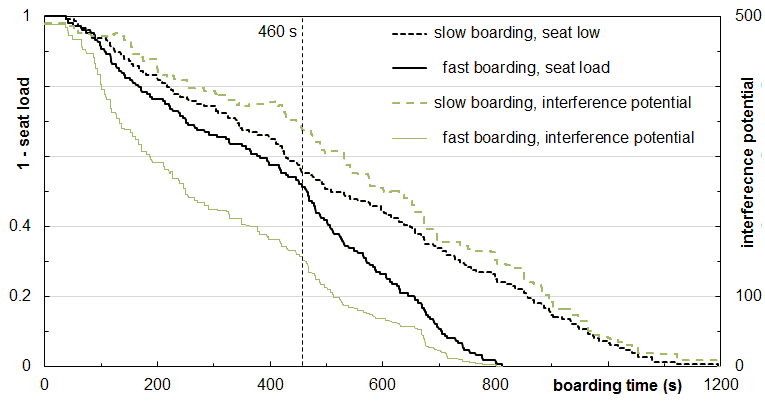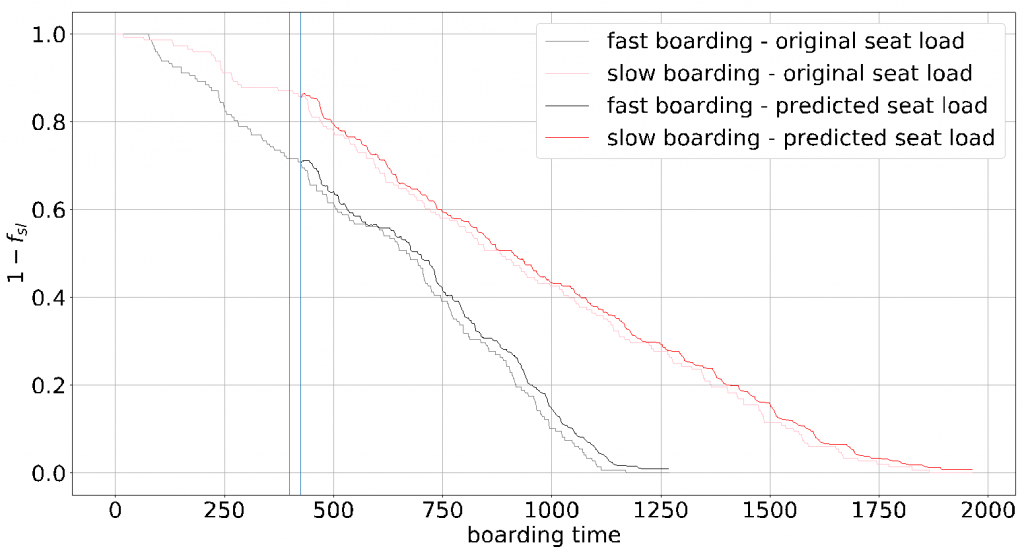Real-time prediction of aircraft boarding will add significant benefit to punctual aircraft turnaround operations (e.g.reduction of uncertainties). Therefore, the boarding model is used to provide real-time status information about boarding progress. This status contains seat load (percentage of seated passengers), interference potential (complexity measure which considers already used seats), and the quality of the boarding sequence (chronological order of passenger arrival). The real-time information are input for a machine learning model, which finally enables an appropriate prediction of the final boarding time. The list of publications can be found here: references.
Complexity metric
The main idea is that a boarding scenario where all aisle seats are occupied first will lead to significantly longer boarding times as a scenario where all window seats are occupied. In the case of occupied aisle seats, passengers have to stand up first before new passengers can take a seat. In the case of occupied window seats, no further interactions will arise, if a new passenger takes the seat. The possible interactions between passengers are aggregated to an interference potential for the current seat occupation in the aircraft.
To provide a closer view of the disturbances during the course of boarding, an example is given in the following figure, where a boarding nearly finishes and 13 seats are still free. From a general, qualified point of view, a free seat at the window with two already occupied seats will result in a high interference between passengers (seat shuffle: two passengers have to move into the aisle), whereas free aisle seats demand no interference during seating. This effect could be more prominent if other passengers have to wait during the luggage/seating process. Having this in mind, the free seats could be ranked according to their interference potential. This interference potential is qualitatively clustered by high, medium, and low level of interferences. Depending on the current boarding sequence, this expected interference could result in high numbers of realized interactions if the seats with the highest potential are boarded first, or result in small numbers if the seats are boarded vice versa.

The next figure shows the characteristic of the interference potential (green lines) over time in comparison to the seat load progress (black lines) using two different boarding events. After 460 s there is no clear indication, which event ends earlier if the seat load progress is used as a reference. But the developed interference potential demonstrates a significant difference between the exemplarily chosen boarding events.

Finally, the complexity metric depends on the already realized boarding progress and three major indicators: seat position in seat row, seat row position in the cabin, and boarding sequence.
Prediction – machine learning
To overcome the resulting complexities and dynamic effects of passenger boarding, time predictions can be applied using advanced statistical procedures, such as neural networks. The developed complexity metric is used as input for the prediction model (LSTM, Long Short-Term Memory). The LSTM model is trained and tested with boarding simulation data (time series) and enables an appropriate prediction of the final boarding time. The following figure shows the prediction results (thick lines) of two boarding events (thin lines). Furthermore, the LSTM model demonstrates that the proposed complexity metric is a necessary element to reliably predict the aircraft boarding progress.

A closer look at differences between boarding progress and prediction shows an inherent positive offset. If this offset could be classified as constant, the prediction shows only a difference of ±20 s. Since operational requirements demand qualitative information about the probability, if a given target time will be reached (boarding ends before) or missed, the developed prediction model is a promising candidate for extended investigations.
References
- Michael Schultz, Stefan Reitmann (2019) Machine learning approach to predict aircraft boarding
- Stefan Reitmann, Michael Schultz (2018) Real-time Prediction of Aircraft Boarding
- Michael Schultz, Stefan Reitmann (2018) Prediction of aircraft boarding time using LSTM network
- Michael Schultz (2018). A metric for the real-time evaluation of the aircraft boarding progress
- Michael Schultz (2018). Fast aircraft turnaround enabled by reliable passenger boarding
- Michael Schultz (2017). Aircraft Boarding – Data, Validation, Analysis
- Michael Schultz, Thomas Kunze, Hartmut Fricke (2013). Boarding on the critical path of the turnaround
- Michael Schultz, Thomas Kunze, Bernd Oreschko, Hartmut Fricke (2013). Microscopic process modelling for efficient aircraft turnaround management
The complete list of publications can be found here: references.
